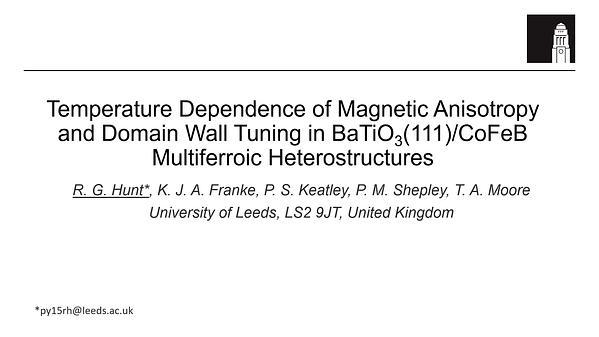Would you like to see your presentation here, made available to a global audience of researchers?
Add your own presentation or have us affordably record your next conference.
The ability to manipulate the topological spin textures, such as magnetic skyrmions, is one of the crucial requirements in advance spintronics research. Recently, attempts have been made to understand the mechanism of Domain wall (DW) pair to skyrmion conversion in a specially designed nanotrack which may be useful in memory and logic operation 1,2. Here, using micromagnetic simulation, we investigate the role of geometry in controlling the DW to skyrmion conversion in a three-channel narrow nanotrack adjoined to a wide nanotrack. Dimension of the nanotrack is as follows; length - 800 nm, thickness - 1 nm, width of narrow nanochannel - 20 nm, width of wider nanochannel - 200 nm, with spacing between the three narrow channels (lower -1, middle - 2, and upper - 3) varied symmetrically and asymmetrically from 10 - 30 nm in step of 10 nm. The simulations are performed using a python interfaced OOMMF known as Ubermag, where a Zhang-Li torque evolver in the Landau-Lifshitz-Gilbert equation is incorporated to understand the magnetization dynamics under the influence of spin current 3. In figure 1, by keeping the separation between narrow channels 1 and 2 as well as 2 and 3 fixed as 10 nm, Gilbert damping α = 0.3 and non-adiabatic torque parameters β = 0.3, conversion of DWs to two skyrmions are shown 4. Interestingly, we note that while the steady state velocity for both the skyrmions are same, the time scale involved in DW to skyrmion for individual skyrmion varies resulting in difference in the x-position. By increasing the separation between channel 2 and 3 to 30 nm and keeping all other parameters fixed, formation of a skyrmion and a meron is observed in figure 2. We envision that such difference in the observation of topological spin texture by changing the separation between the narrow nanochannels will be useful for implementing futuristic skyrmion-based logic gate devices.
References
1 A. Fert, V. Cross, J. Sampaio Nature Nanotech., Vol. 8, p. 152, (2013).
2 Y. Zhou, M. Ezawa, Nat. Commun., Vol. 5, p. 4652, (2014).
3 M. Beg, M. Lang, H. Fangohr., IEEE Trans. Magn. Vol. 58, p. 1-5 (2021)
4 P. Hari Prasanth, Syamlal S K, B. Priyanka, J. Sinha, Manuscript under preparation.

Fig 1: Snapshot of DW to skyrmion conversion from the three symmetrically separated narrow nano-channels for α = β = 0.3 and separation - 10 nm.

Fig 2: From asymmetrically separated narrow nano-channels (separation between 1 and 2 - 10 nm and between 2 and 3 - 30 nm) and for α = β = 0.3 conversion of DWs into a skyrmion and a meron.
